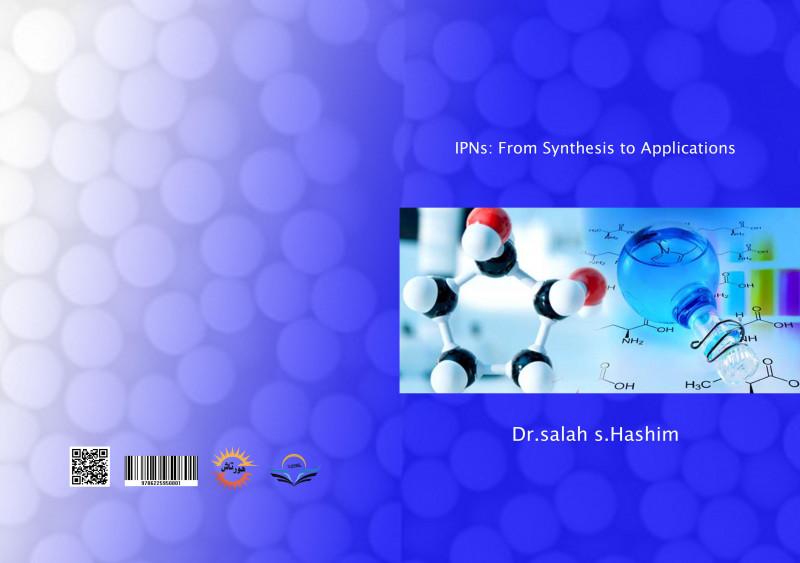کتاب IPNs: From Synthesis to Applications
- صفحه نخست
- رشته ها
- فنی و مهندسی
- پلیمر
- کتاب IPNs: From Synthesis to Applications
کتاب IPNs: From Synthesis to Applications
۴۲۹,۰۰۰ تومان Original price was: ۴۲۹,۰۰۰ تومان.۲۱۴,۵۰۰ تومانCurrent price is: ۲۱۴,۵۰۰ تومان.
| تعداد صفحات | 143 |
|---|---|
| شابک | 978-622-5950-80-1 |
| انتشارات |
کتاب IPNs: From Synthesis to Applications
کتاب IPNs: From Synthesis to Applications یکی از منابع ارزشمند در حوزه علوم مواد و پلیمرها است که به بررسی شبکههای پلیمری درهمتنیده (Interpenetrating Polymer Networks – IPNs) از مرحله سنتز تا کاربردهای صنعتی و علمی آن میپردازد. این کتاب با ارائه اطلاعات جامع و مستند، مخاطبان خود را با جنبههای مختلف این فناوری پیشرفته آشنا میکند.
درباره کتاب
شبکههای پلیمری درهمتنیده، بهعنوان یکی از نوآوریهای کلیدی در حوزه علوم مواد، نقش بسزایی در توسعه مواد با خواص چندمنظوره دارند. این کتاب از مراحل اولیه سنتز IPNs شروع کرده و تا بررسی خواص مکانیکی، حرارتی و شیمیایی آنها پیش میرود. همچنین، نویسنده با ارائه مثالهای کاربردی، نقش IPNs را در صنایع مختلف نظیر پزشکی، هوافضا و بستهبندی نشان میدهد.
موضوعات کلیدی کتاب
- مفاهیم بنیادین IPNs: تعریف، انواع و مزایای شبکههای پلیمری درهمتنیده.
- فرایندهای سنتز: روشهای مختلف تولید IPNs و چالشهای مرتبط با آنها.
- خواص فیزیکی و شیمیایی: تحلیل خواص منحصربهفرد این مواد و تأثیر آنها در کاربردهای مختلف.
- کاربردهای صنعتی: نقش IPNs در پزشکی (مانند دارورسانی و ایمپلنتها)، صنایع خودروسازی، هوافضا و بستهبندی.
- پیشرفتهای تحقیقاتی: نوآوریها و مطالعات اخیر در زمینه شبکههای پلیمری درهمتنیده.
ویژگیهای برجسته کتاب
- جامع و کاربردی: ارائه اطلاعات از اصول اولیه تا پیشرفتهترین کاربردها.
- تحلیلهای علمی عمیق: مناسب برای محققان و متخصصان حوزه علوم مواد.
- تصاویر و جداول مفید: برای توضیح بهتر مفاهیم و روشها.
- پوشش کاربردهای چندگانه: از صنایع پیشرفته تا استفادههای روزمره.
چرا این کتاب را بخوانیم؟
- برای درک بهتر مفهوم و اهمیت شبکههای پلیمری درهمتنیده.
- برای یادگیری روشهای پیشرفته تولید مواد با خواص بهینه.
- برای کشف کاربردهای نوین IPNs در صنایع مختلف.
- برای مطالعه جدیدترین تحقیقات و دستاوردهای علمی در این زمینه.
مخاطبان کتاب
- دانشجویان و پژوهشگران رشتههای مهندسی مواد، شیمی و پلیمر.
- مهندسان و متخصصان فعال در صنایع شیمیایی، پزشکی و هوافضا.
- علاقهمندان به فناوریهای نوین در علوم مواد.
- مدیران و تصمیمگیران صنعتی که به دنبال بهبود و نوآوری در تولید مواد پیشرفته هستند.
سفارش کتاب
برای ورود به دنیای پیشرفته شبکههای پلیمری و کشف کاربردهای متعدد آنها، کتاب IPNs: From Synthesis to Applications منبعی جامع و ضروری برای مطالعه است. این کتاب راهنمای شما برای درک بهتر این فناوری شگفتانگیز خواهد بود.
۱. IPNs چیست و چگونه تعریف میشود؟
🧬 پاسخ: IPNs (Interpenetrating Polymer Networks) به شبکههای پلیمری متقاطع گفته میشود که در آنها دو یا چند شبکه پلیمری بهطور جداگانه در یک ماتریس به هم نفوذ میکنند. این ساختار به مواد خواص ویژهای میدهد که به دلیل ترکیب دو یا چند نوع پلیمر بهوجود میآید.
۲. روشهای سنتز و ویژگیهای IPNs چگونه است؟
🔬 پاسخ: سنتز IPNs معمولاً از طریق روشهایی مانند پلیمریزاسیون همزمان یا پلیمریزاسیون متوالی انجام میشود. این روشها بهدلیل ترکیب دو یا چند پلیمر مختلف، ویژگیهای مکانیکی، حرارتی و شیمیایی منحصر به فردی را ایجاد میکنند که میتوانند کاربردهای مختلفی داشته باشند.
۳. خواص مکانیکی IPNs چه تأثیری در کاربردهای آن دارند؟
💪 پاسخ: خواص مکانیکی IPNs شامل استحکام کششی، سختی، انعطافپذیری و مقاومت در برابر سایش است. این ویژگیها باعث میشود IPNs در صنایع مختلف مانند خودروسازی و تجهیزات پزشکی کاربردهای فراوانی داشته باشند.
۴. ویژگیهای حرارتی و شیمیایی IPNs چیست؟
🔥 پاسخ: IPNs ویژگیهای حرارتی و شیمیایی مانند دمای ذوب بالا، پایداری در برابر حرارت، و مقاومت در برابر مواد شیمیایی مختلف دارند. این ویژگیها به آنها امکان استفاده در محیطهای سخت مانند صنایع شیمیایی و الکترونیکی را میدهند.
۵. خواص الکتریکی و نوری IPNs چگونه هستند؟
⚡ پاسخ: IPNs دارای خواص الکتریکی و نوری منحصر به فردی هستند که میتوانند در فناوریهای نانو، حسگرها، و اپتوالکترونیک کاربرد داشته باشند. این خواص به دلیل ترکیب پلیمرهای مختلف با ویژگیهای خاص در زمینه هدایت الکتریکی و عبور نور شکل میگیرد.
۶. کاربردهای بیومدیکال IPNs چیست؟
💉 پاسخ: IPNs در پزشکی و بیومواد کاربردهای فراوانی دارند، از جمله در طراحی ایمپلنتها، دارورسانی هدفمند، و باندها و پروتزهای پزشکی. ویژگیهایی مانند سازگاری زیستی و توانایی تغییر در پاسخ به محرکها باعث استفاده گسترده از آنها در این زمینه شده است.
۷. IPNs در پوششها، چسبها و کامپوزیتها چه نقشی دارند؟
🔧 پاسخ: IPNs در صنعت پوششها، چسبها و کامپوزیتها بهدلیل خواص مکانیکی و شیمیایی عالی خود بسیار مفید هستند. این مواد میتوانند بهعنوان پوششهای مقاوم در برابر خوردگی و چسبهای قوی در ساختوساز و صنایع خودروسازی بهکار روند.
۸. آینده و تحقیقات نوین در زمینه IPNs به کجا میرود؟
🔮 پاسخ: تحقیقات آینده در زمینه IPNs بهدنبال بهبود سنتز، ویژگیها و کاربردهای آنها در زمینههای مختلف از جمله فناوریهای نوین، بیومواد و مواد هوشمند است. توسعه استفاده از IPNs در صنایع پیشرفته مانند نانو فناوری و ساخت مواد با خواص خاص از زمینههای تحقیقاتی مهم در آینده خواهند بود.
۹. IPNs چه تأثیری در توسعه مواد پیشرفته دارد؟
🧪 پاسخ: IPNs میتوانند نقش کلیدی در توسعه مواد پیشرفته ایفا کنند زیرا ترکیب پلیمرهای مختلف به آنها خواص متنوع و منحصر به فردی میدهد. این مواد میتوانند برای تولید قطعات با استحکام بالا، مقاومت در برابر شرایط محیطی سخت، و عملکرد بهینه در صنایع مختلف استفاده شوند.
| تعداد صفحات | 143 |
|---|---|
| شابک | 978-622-5950-80-1 |
| انتشارات |
محصولات مشابه
-
کتاب ریزشبکهها و سیستمهای کنترل
۳۱۹,۲۸۶ تومانOriginal price was: ۳۱۹,۲۸۶ تومان.۱۸۳,۵۸۹ تومانCurrent price is: ۱۸۳,۵۸۹ تومان. -
کتاب نانو ذرات و خصوصیات عملکردی و زیست محیطی بتن آسفالتی
۳۱۹,۲۸۶ تومانOriginal price was: ۳۱۹,۲۸۶ تومان.۱۸۳,۵۸۹ تومانCurrent price is: ۱۸۳,۵۸۹ تومان. -
کتاب استاتیک 1
۶۶۶,۰۰۰ تومانOriginal price was: ۶۶۶,۰۰۰ تومان.۲۹۹,۷۰۰ تومانCurrent price is: ۲۹۹,۷۰۰ تومان. -
کتاب مجموعه سؤالات تستی مهارت تعمیر اتومبیل سواری درجه 2
۴۳۸,۰۰۰ تومانOriginal price was: ۴۳۸,۰۰۰ تومان.۲۱۹,۰۰۰ تومانCurrent price is: ۲۱۹,۰۰۰ تومان.












